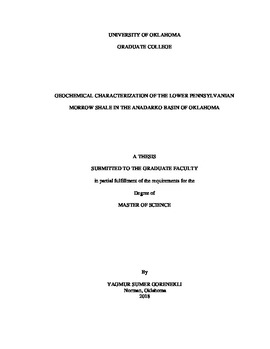| dc.description.abstract | The Morrow Formation is one of the most widespread units of Early Pennsylvanian time in the Anadarko Basin. While the Morrow Sandstone has been one of the most productive oil and gas reservoirs since the 1950s, the Morrow Shale has become important recently due to developments in the unconventional shale sector. The publicly available geochemical information about this formation is very limited. Therefore, this study investigates the geochemical characteristics of the Morrow Shale in the Anadarko Basin and will help to fill the gap in the literature on geochemical characteristics of the Morrow Formation.
Fifteen Morrow source rock samples from different parts of the Anadarko Basin and source rock samples from two different wells in the area were geochemically characterized by means of bulk geochemical and biomarker data. The Rock-Eval Pyrolysis data including Total Organic Carbon (TOC), S1 (free hydrocarbons already present in the source rock), S2 (potential generative capacity), Tmax (maturity level of the sample) and hydrogen and oxygen indexes (HI and OI) indicate that the Morrow source rocks are fair to good source rocks, characterized by the Type-III kerogen that has gas generating capacity and is thermally mature.
Biomarker analyses of the source rocks extracts were conducted by gas chromatography (GC) and gas chromatography-mass spectrometry (GC-MS). The aliphatic and aromatic biomarker results demonstrated that the Morrow Shale is composed of mixed organic matter with more pronounced terrestrial input than marine. Depositional conditions were interpreted as a near-shore/transitional depositional environment which was subjected to periodic terrigenous influx by fluvial activities.
The abundance of the C29 17(α)-hopane in some of the rock extracts was interpreted as increasing carbonate content or evaporitic conditions in the depositional environment. Alternatively, relatively high concentrations of rearranged hopanes (18(α)-30-norneohopane and 17(α)-diahopane) reveals that the Morrow was deposited under clay-rich, brackish/freshwater conditions of a suboxic depositional environment.
The tentative presence of 18α(H)-oleanane was confirmed in the Morrow source rock samples. 18α(H)-Oleanane is a biomarker derived from angiosperm plants and commonly used as an age-specific biomarker for Cretaceous and younger rocks. Its presence in pre-Cretaceous rocks is uncommon but has been confirmed by Moldowan et al. (1994), Peters et al. (1999) and Taylor et al. (2006). Moreover, 1,2,7-trimethylnaphthalene (1,2,7-TMN), a proposed alteration product of 18α(H)-oleanane, or oleanane type marker, was identified in all of the studied samples. The presence of 18α(H)-oleanane and 1,2,7-TMN in the Morrow source rocks suggests that they are either derived from angiosperms that evolved long before the Cretaceous or were derived from a sister-group of angiosperms that share common characteristics with the angiosperms and were capable of synthesizing β-amyrin or other related compounds. Demethylated hopanes such as 25-norhopanes (NHP), 25,28,30-trisnorhopane (TNH), 25,30-bisnorhopane are commonly found in biodegraded oils and their presence in the rock extracts is unusual as they are not found in the pyrolysis products of the kerogen and therefore they should be present in the sediments as free hydrocarbon. This study confirms the tentative presence of demethylated hopanes in multiple source rock samples and is interpreted as paleo-seepage from an ancient heavily biodegraded reservoir or in-situ biodegradation of the oil at the fissures and fractures of the Morrow Shale.
Finally, the presence of pyrolytic polycyclic aromatic hydrocarbons (PAHs) in the Morrow source rocks revealed that paleo-wildfires were part of the terrestrial ecosystem during Early Pennsylvanian time revealed by high concentrations of pyrene, fluoranthene, benzopyrenes, benzofluoranthenes, benzo(a)anthracene, triphenylene, and chrysene in the source rock extracts. The presence of cadalene, fluorene and dibenzofuran provide supporting evidence for the Morrow being a freshwater/brackish water shale deposited under fluvio-deltaic conditions. | en_US |
